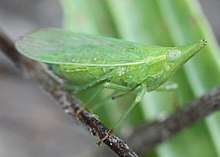Dictyophara europaea
Dictyophara europaea, common name European lantern fly, is a species of planthoppers belonging to the family Dictyopharidae, subfamily Dictyopharinae.[1]
| Dictyophara europaea | |
|---|---|
 | |
| Dictyophara europaea | |
| Scientific classification | |
| Kingdom: | |
| Phylum: | |
| Class: | |
| Order: | |
| Family: | |
| Genus: | |
| Species: | D. europaea |
| Binomial name | |
| Dictyophara europaea (Linnaeus, 1767) | |
| Synonyms | |
| |
Etymology
The scientific genus name Dictyophara derives from the Greek (dictyon: net and phorein: wear) and can be translated "who wears a net". The common name European lantern fly is actually derived from a species (Fulgora laternaria) belonging to another family (Fulgoridae).[2]
Subspecies
- Dictyophara europaea rosea Costa, 1862 [3]
Distribution
This species can be found in most of Europe, in North Africa and in the East Palearctic ecozone (Afghanistan, Albania, Austria, Belgium, Bulgaria, Denmark, France, Germany, Greece, Hungary, Iran, Italy, Kazakhstan, Kyrgyzstan, Moldova, Montenegro, Poland, Portugal, Romania, Serbia, Spain, Sweden, Switzerland, Tunisia, Turkey, Ukraine and Xinjiang).[3][4]
Habitat
These insects occurs in dry grasslands and warm open areas.
Description
Dictyophara europaea can reach a body length of about 9–13 mm (0.35–0.51 in). These planthoppers have an ovoidal light green body and a conical head extended forward with two strong longitudinal keels and a middle keel converging to the tip. Also the pronotum shows a middle keel and two lateral keels. The forewings are about the same size as the hind wings. Wings are transparent (hyaline) with rich green veining. The distal part of the fore wings has a network formed by the veins. The larvae are similar to the imago in color, shape and head shape.[5] The rarer subspecies Dictyophara europaea rosea shows a pinkish body.
Biology
Adults can be found from June to October. These insects live among herbaceous plants feeding on sap. The eggs are deposited by the female in the soil and thereby individually covered with earth by special structures of the ovipositor.[6] These plasnthoppers can communicate with conspecifics by vibration signals.[7]
This species is univoltine and polyphagous. The main recorded host plants belong to the family of Asteraceae (Achillea millefolium, Crepis foetida, Sonchus asper), Poaceae (Agropyron repens, Setaria viridis), Amaranthaceae (Amaranthus retroflexus), Ranunculaceae (Clematis vitalba) and Plantaginaceae (Linaria vulgaris).[3][8]
References
| Wikispecies has information related to Dictyophara europaea |
| Wikimedia Commons has media related to Dictyophara europaea. |
- "Dictyophara europaea". BioLib.cz. Retrieved 2019-09-12.
- Herbert Nickel (2013): Zur Etymologie der Zikadennamen Mittel- und Nordeuropas. Acta Musei Moraviae, Scientiae biologicae (Brno) 98(2): 273-315 (in German)
- "Planthoppers: FLOW Website". hemiptera-databases.org. Retrieved 2019-09-12.
- "Dictyophara (Dictyophara) europaea (Linnaeus, 1767)". Fauna Europaea. Retrieved 2019-09-12.
- Zhi-Shun Song & Ai-Piing Liang (2008): The Palaearctic Planthopper Genus Dictyophara Germar, 1833 (Hemiptera: Fulgoroidea: Dictyopharidae) in China. Annales Zoologici 58(3):537-549. doi:10.3161/000345408X364364
- Reinhard Remane & Ekkehard Wachmann: Zikaden kennenlernen, beobachten. Naturbuch Verlag, Augsburg, 1993. ISBN 3-89440-044-7 (in German)
- Malcolm Burrows (2014): Jumping mechanisms in dictyopharid planthoppers (Hemiptera, Dicytyopharidae). Journal of Experimental Biology 217: 402-413. doi:10.1242/jeb.093476
- Oliver Krstic, Tatjana Cvrkovic, Milana Mitrovic, Ivo Tosevski Dictyophara europaea (Hemiptera: Fulgoromorpha: Dictyopharidae): description of immatures, biology and host plant associations Bulletin of Entomological Research 106(3):395-405